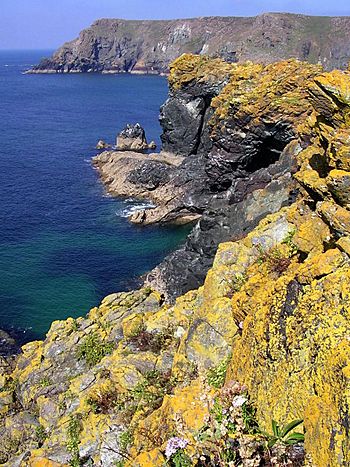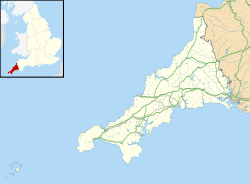Asparagus Island facts for kids

Seaward side of Asparagus Island
|
|
| Geography | |
|---|---|
| Location | Mount's Bay |
| Coordinates | 49°58′26″N 5°13′59″W / 49.974°N 5.233°W |
| Length | 0.24 km (0.149 mi) |
| Width | 0.1 km (0.06 mi) |
| Administration | |
|
England
|
|
| County | Cornwall |
| Demographics | |
| Population | 0 |
Asparagus Island (called Enys Merlosowen in the Cornish language) is a small tidal island. It sits on the eastern side of Mount's Bay in Cornwall, United Kingdom. You can find it within Kynance Cove, which is a very popular place for tourists. The island gets its name from a special type of wild asparagus (Asparagus prostratus) that grows there.
Contents
What is Asparagus Island Like?
Asparagus Island is a small piece of land that is usually surrounded by water. However, at low tide, you can sometimes walk to it from the mainland. This is why it's called a "tidal island." It's not a place where people live.
How Asparagus Island Was Formed
The rocks that make up Asparagus Island are part of the Lizard peninsula. This area is famous for its unique rocks and plants. Millions of years ago, very hot, melted rock deep inside the Earth slowly pushed upwards. This rock changed over time into a type of rock called serpentinite.
The island itself is made of a specific kind of serpentinite called tremolite serpentine. This rock is different because it was under even more pressure. Over time, the sea has worn away softer rocks around it, leaving the harder island behind.
Cool Features of the Island
Asparagus Island has some amazing natural features.
- The Devil's Bellows: At about half-tide, you can hear a loud "snorting" sound. This comes from a blowhole called the Devil's Bellows. It's a tunnel in the rock created by the sea.
- The Post Office: There's another blowhole nearby called the Post Office. It's said that if you drop a letter into it, the sea's suction is strong enough to "post" it!
You can reach the island by walking along the South West Coast Path. There's a National Trust car park nearby.
Wildlife and Special Plants
Asparagus Island is part of the Lizard National Nature Reserve. These reserves protect the best habitats and geological sites in England.
- Wild Asparagus: The island is home to a rare plant called wild asparagus. This plant is so special that it's listed in the "red data book" of endangered species. People have known about it growing here since the 1830s. In the past, tour guides would sometimes pick it, which put it in danger.
A Shipwreck Story
Asparagus Island has a bit of history too.
- The Ospra Wreck: On May 6, 1832, a Danish ship called the Ospra crashed into Asparagus Island. The ship was carrying valuable sugar and coffee from Havana to Hamburg. Most of the crew managed to climb onto the island and get to shore safely, but one person sadly drowned. The ship and its cargo were completely lost. Locals still remember this event as the "coffee wreck."


